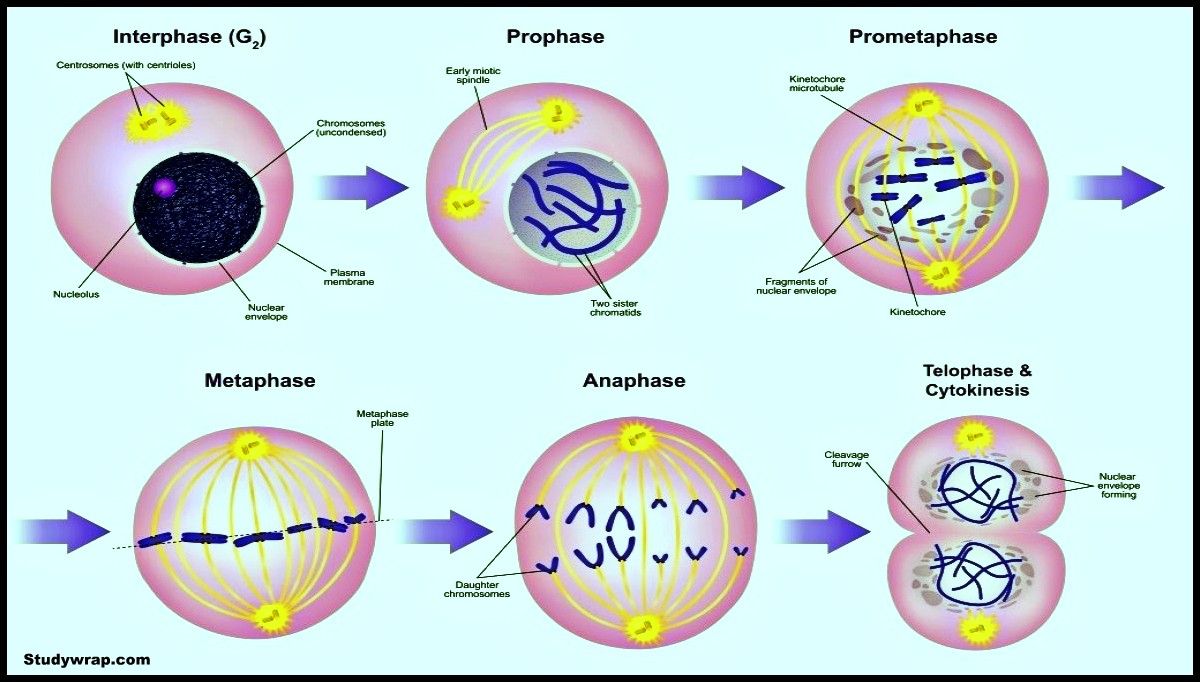Science
Mitosis – Somatic Cell Division and its Significance
Mitosis – Somatic Cell Division
Table of Contents
Mitosis – Somatic Cell Division
- Mitosis is a cell Division in which a parent cell divides into two daughter cells of about equal size with same chromosome numbers as that of parent cells.
- It is a type of cell division by which two identical daughter cells are formed from single parent cell with same chromosome numbers.
- Types of cells which undergoes Mitosis – All somatic cells except reproductive cells.
- The Mitosis is divided into following phases –
-
- Karyokinesis
-
- Prophase
- Metaphase
- Anaphase
- Telophase
-
- Cytokinesis
- Karyokinesis
-
1. Karyokinesis
-
- Division of Nucleus is known as Karyokinesis.
- Karyokinesis is divided into 4 phases namely,
-
- Prophase
- Metaphase
- Anaphase
- Telophase
-
- Prophase is the First phase of the Karyokinesis which marks the starting of cell division.
- Telophase is the last stage of Karyokinesis which marks the division of nucleus is completed.
- After Telophase the cell enters the Cytokinesis.
a. Prophase
-
- First visible stage and longest in Karyokinesis.
- Chromatin fibres becomes shorter, thicker and visible due to the condensation of DNA.
- Chromatin condenses into thread like structure called chromosomes.
- Each chromosome is composed of two sister chromatids. These sister chromatids are attached with each other at centromere.
- Centrosome divides into two centrioles which moves to opposite poles.
- Fine fibres called astral rays forms aster of centrioles. Microtubules between two asters forms spindles.
- The nuclear membrane and nucleolus starts to disappear and by the end it will completely disappeared.
- Stainability of nucleus increase.
b. Metaphase
-
- Nuclear membrane and nucleolus completely disappears and simultaneous appearance of spindle fibres occurs in Late Prophase.
- Chromosomes become more thicker and short.
- Spindle fibres gets attached to the centromere of chromosome.
- The chromosomes are arranged on the equatorial plane.
- The process of gathering of chromosomes in equator is called congression and plate formed is called metaphasic plate.
c. Anaphase
-
- It is shortest phase and is also known as migratory phase.
- Centromere of each chromosome splits into two sister chromatids and forms two daughter chromosomes.
- The daughter chromosomes are pulled towards the poles due to the contraction and stretching of spindle fibres.
- During polar movement, the chromosomes shows different shapes i.e. J,U,V,L or I shaped in appearance.
- At the end of anaphase, each pole will get one set of daughter chromosomes.
d. Telophase
-
- Chromosome form two groups on each pole.
- The daughter chromosomes uncoils and become thin, long and visible and forms chromatin net.
- Spindle fibres start disappearing and finally disappear.
- Nuclear membrane and the Nucleolus reappear.
- Two nuclei are formed at the end of telophase with same number of chromosome as parent cell.
- It is the last visible stage of Karyokinesis and is also known as reorganization phase.
- A furrow starts to form and deepening in animal cells. (cell plate in plant cells)
2. Cytokinesis
- Cytokinesis is the division of the cytoplasm.
- In plant cells, cytokinesis occurs by cell plate formation.
- During cytokinesis, many granular matrix formed by the Golgi body and endoplasmic reticulum accumulates in the equatorial region. These granular matrix form cell plate. This plate divides the cell and by the end of telophase, cytokinesis is completed.
- In animal cells, cytokinesis occurs by cleavage or furrow formation.
Significance of Mitosis
- Mitosis produces two genetically identical cells, so mitosis maintains the genetic stability of organisms.
- DNA remains constant, mitosis keeps the chromosomes number constant in a species.
- Mitosis helps in the growth and development of multicellular organism.
- Mitosis helps to replacement of old, dead or damaged cells by new one.
- It helps in the recovery and repair of wounds and injury of the body by formation of new cells.
- In unicellular organisms like Yeast, Paramecium , mitosis is a means of asexual reproduction.
- Mitosis causes maturation and multiplication of germ cells and makes them ready for meiosis.
Difference b/w Mitosis in animal and Plant cell
|
Animal Cell |
Plant Cell |
|
Asters are formed |
Asters are not formed. |
|
Cytokinesis by furrowing of Cytoplasm |
Cytokinesis by Cell plate formation. |
|
Occurs in most tissues throughout the body for growth and replacement. |
Occurs at growing tips and sides for lengthening and increase in girth. |
|
Centrioles are present. |
Centrioles are absent. |
So, this was all about the Somatic Cell Division – Mitosis and its Significance.
In the Next Post (Click Here), We will discuss about the another process of Cell Division known as Meiosis for Reproductive Cells.




Thanks for the notes
Does Interphase proceeds the karyokinesis in cell division?
Thanks for sharing
I believe that is among the most important info for me. Excellent job, cheers
Just wish to say your article is as astonishing. The clarity in your post is just great. Thanks a million and please carry on the rewarding work.
I truly appreciate this post. I have been looking all over for this! Thank goodness I found it on Bing. You’ve made my day! Thanks again
thanks
Happy to find these notes … helped me out in my exam preparation thanks
Wow, great article post.Much thanks again. Cool.